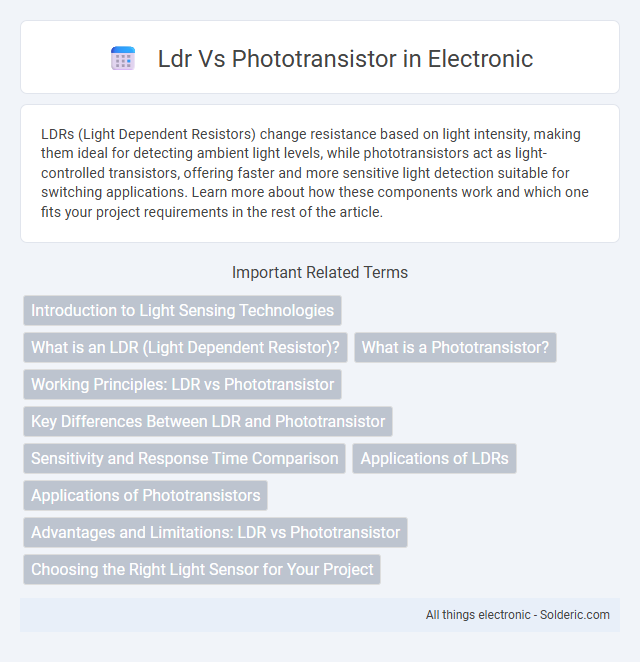LDRs (Light Dependent Resistors) change resistance based on light intensity, making them ideal for detecting ambient light levels, while phototransistors act as light-controlled transistors, offering faster and more sensitive light detection suitable for switching applications. Learn more about how these components work and which one fits your project requirements in the rest of the article.
Comparison Table
| Feature | LDR (Light Dependent Resistor) | Phototransistor |
|---|---|---|
| Function | Resistor with resistance varying by light intensity | Transistor that amplifies current based on light received |
| Response Time | Slow (milliseconds to seconds) | Fast (microseconds to milliseconds) |
| Sensitivity | Moderate sensitivity | High sensitivity to light |
| Output Type | Variable resistance (analog) | Current output (analog or digital with circuitry) |
| Light Spectrum | Visible light only | Visible and near-infrared light |
| Power Consumption | Passive, no power required | Requires power supply for transistor action |
| Applications | Light meters, night lights, simple light detection | Optical switches, light sensors, remote controls |
| Cost | Lower cost | Higher cost compared to LDR |
Introduction to Light Sensing Technologies
Light sensing technologies primarily include Light Dependent Resistors (LDRs) and phototransistors, both designed to detect and respond to varying light intensities. LDRs change resistance based on light exposure, offering simplicity and low cost for ambient light detection, while phototransistors provide faster response times and higher sensitivity through semiconductor amplification, making them suitable for precise optical signal detection. Understanding the operational principles and performance characteristics of LDRs versus phototransistors allows for optimized selection in applications ranging from automatic lighting control to optical communication systems.
What is an LDR (Light Dependent Resistor)?
An LDR (Light Dependent Resistor) is a resistor whose resistance decreases as the intensity of incident light increases, making it a passive optical sensor. Its composition typically involves semiconductor materials like cadmium sulfide (CdS), which alters conductivity based on light exposure. LDRs are widely used in light-sensing circuits for automatic brightness control and night detection systems due to their simple structure and cost-effectiveness.
What is a Phototransistor?
A phototransistor is a semiconductor device that amplifies current when exposed to light, functioning as a light-sensitive switch. Compared to LDRs (Light Dependent Resistors), phototransistors offer faster response times and greater sensitivity to specific light wavelengths. Key applications include optical sensors, light meters, and photointerruptors in electronic circuits.
Working Principles: LDR vs Phototransistor
LDRs (Light Dependent Resistors) operate by changing their resistance based on the intensity of incident light, utilizing photoconductivity in semiconductor materials. Phototransistors function by converting light into an electrical current, with the light acting as the base current to control the transistor's collector-emitter conduction. The key difference in working principles is that LDRs modulate resistance in a passive manner, while phototransistors actively amplify the photocurrent, enabling faster and more sensitive light detection.
Key Differences Between LDR and Phototransistor
LDRs (Light Dependent Resistors) change resistance based on light intensity, while phototransistors generate current proportional to light, offering faster response times and higher sensitivity. Phototransistors are ideal for applications requiring rapid light detection and electronic switching, whereas LDRs are suited for simple light sensing with slower response. Understanding these key differences helps optimize Your choice for precise light measurement or control systems.
Sensitivity and Response Time Comparison
Phototransistors exhibit higher sensitivity than LDRs, making them more effective in low-light conditions due to their ability to amplify photocurrent internally. The response time of phototransistors is significantly faster, typically in the microsecond range, compared to the slower response time of LDRs, which can be in the milliseconds to seconds range. This makes phototransistors ideal for applications requiring quick detection of light changes, while LDRs are better suited for general light measurement where speed is less critical.
Applications of LDRs
LDRs (Light Dependent Resistors) are widely used in applications requiring light sensing, such as automatic street lighting, night lights, and alarm systems, where their resistance changes with light intensity. Unlike phototransistors, which provide faster response times and higher sensitivity for precise optical detection, LDRs excel in cost-effective, low-precision environments where gradual light changes need monitoring. Your choice of LDRs is ideal for energy-saving devices and environmental light sensors that demand durability and simplicity over speed and accuracy.
Applications of Phototransistors
Phototransistors are widely used in applications requiring sensitive light detection, such as optical switches, smoke detectors, and ambient light sensors for display brightness control. Their fast response time and high sensitivity make them ideal for pulse detection in remote controls and optical communication systems. You can rely on phototransistors for precise light measurement in industrial automation and medical devices where accurate and rapid detection is crucial.
Advantages and Limitations: LDR vs Phototransistor
LDRs offer low cost and simple construction, making them ideal for sensing ambient light levels, but they have slower response times and lower sensitivity compared to phototransistors. Phototransistors provide faster response and higher sensitivity with better spectral selectivity, suitable for precise light detection in circuits, though they are typically more expensive and require a power source. Choosing between LDR and phototransistor depends on your application's need for speed, sensitivity, and budget constraints.
Choosing the Right Light Sensor for Your Project
When choosing between an LDR and a phototransistor for your project, consider the response speed and sensitivity required; phototransistors offer faster response times and higher sensitivity to light intensity compared to LDRs. LDRs, or Light Dependent Resistors, are cost-effective and suitable for simple applications where precise light measurement is not critical. Your choice depends on whether you prioritize quick detection and accuracy (phototransistor) or affordability and basic illumination sensing (LDR).
ldr vs phototransistor Infographic

 solderic.com
solderic.com